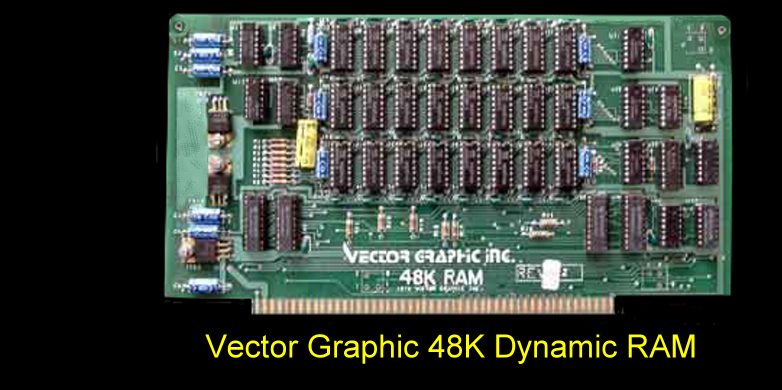The Vector Graphic 48K Dynamic Memory
Board provided 49,152 8-bit bytes of random access memory, using 24 16K dynamic
memory chips. They claimed it could be used in ANY S-100 bus computer
using a Z-80 CPU board -with minor modifications. It occupies the lower 48K of
memory, i.e. beginning at 0000H. The Vector Graphic 48K Dynamic Memory Board was
a bit of a breakthrough in cost effectiveness. This was accomplished by
combining compact inexpensive dynamic memory chips with the use of the refresh
provisions of the -80 CPU. The static RAM boards of the time cost considerably
more, take up more space, and require more power. Other dynamic memory boards
use complex support logic on the board, rather than the built in
features of the Z-80. In addition to the above features, the Vector
Graphic Dynamic Memory Board quite reliable. Considerable attention was given
during design of the board to the elimination of noise. It features a gridded
ground plane designed to reduce noise. Accepted design practice was observed in
structuring grounds, power supply, and bypass. capacitors.
There were complications however with
some systems involving the RESET S-100 line (pin 75). The modification involves
changing the reset circuit of the CPU board so that it responds to the short
reset pulse generated by this 48K RAM board on pin 55 rather than responding
directly to the PRESET signal on pin 75 typically generated by a front panel
reset switch. -This modification prevents the CPU from being held in a reset
state for longer than 2 milliseconds which would result in loss of memory data,
since the memory is not being refreshed while the CPU is in a reset state. The
manual below outlines what needed to be done. There were also problems
with old front panel READY line putting the Z80 in an extended wait state thus
blocking RAM refresh on this board. Indeed some PROM programming boards/software
caused problems for the same reason. Don't even think about using this
arrangement with a master/slave IEEE S-100 bus system. All in all the
arrangement of utilizing the Z80 refresh signal on the bus did not catch on.
Better arrangements was to have a refresh controller on the board itself. The
SD Systems
ExpandoRAM being a perfect example.
The schematic for this card card can be
seen
here.
The manual for this card can be obtained
here.

